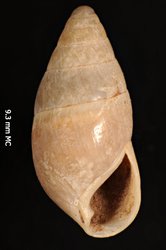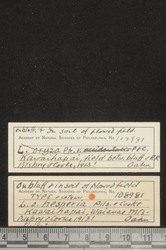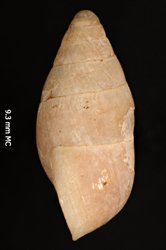< Back to Search Results
New Search >
lectotype Leptachatina oryza hesperia
ANSP Malacology Collection Specimen Search Details
ANSP 108981Amastridae
Amastridae lectotype Leptachatina oryza hesperia
Dry Catalog # 108981
Count 1
Catalog date 1913
donor Pilsbry Cooke
donation date
provenance Pilsbry Cooke
Pilsbry Expedition
Count 1
Catalog date 1913
donor Pilsbry Cooke
donation date
provenance Pilsbry Cooke
Pilsbry Expedition
Alcohol Catalog #
Count
Catalog date
Preservative
Prefixative
Fixative
Postfixative
Count
Catalog date
Preservative
Prefixative
Fixative
Postfixative
ecology
unnamed locality
specific locality Kawaikapai, field between bluff and Railroad, Oahu
secondary division Honolulu County
primary division Hawaii
country USA
original locality Kawaikapai, field between bluff and Railroad, Oahu [eledger]; Oahu: Kawaihapai, in soil of plowed field between the railroad and the bluff, and on the latter [original description]
Coordinates
source of coordinates
unnamed locality
specific locality Kawaikapai, field between bluff and Railroad, Oahu
secondary division Honolulu County
primary division Hawaii
country USA
original locality Kawaikapai, field between bluff and Railroad, Oahu [eledger]; Oahu: Kawaihapai, in soil of plowed field between the railroad and the bluff, and on the latter [original description]
Coordinates
source of coordinates
expedition Pilsbry Expedition
vessel
station
collector Pilsbry & Cooke
date collected 1913
collecting gear
site size
slope
aspect
altitude
depth
pH
salinity
surface temp.
bottom temp.
sediment
associated taxa
vessel
station
collector Pilsbry & Cooke
date collected 1913
collecting gear
site size
slope
aspect
altitude
depth
pH
salinity
surface temp.
bottom temp.
sediment
associated taxa
Remarks
ANSP 108981
remarks 28 paralectotypes split from this lot and recatalogued as ANSP 464878 on 7/28/2015.
Citations
ANSP 108981
Pilsbry & Cooke, 1914. Manual of Conchology (Ser. 2) 23 (89): 5, pl. 10, fig. 10, 11
H. B. Baker, 1963. Proceedings of the Academy of Natural Sciences of Philadelphia 115 (8): 198






